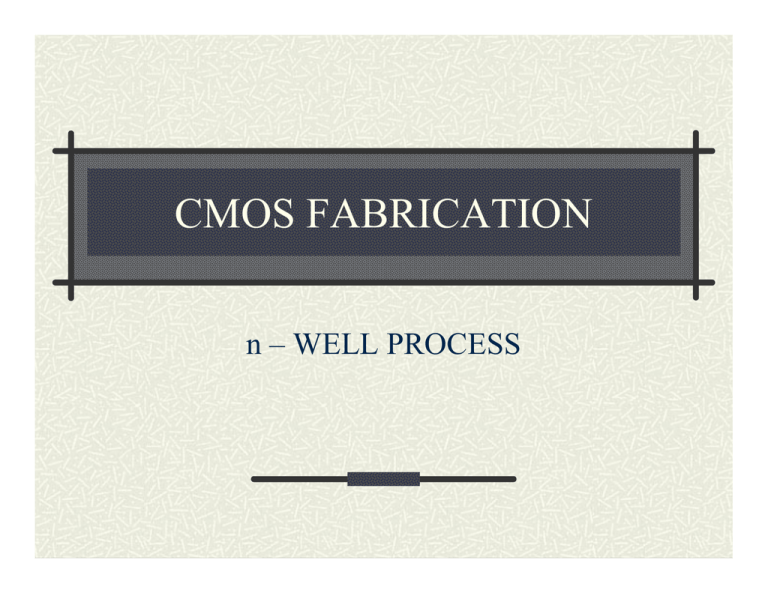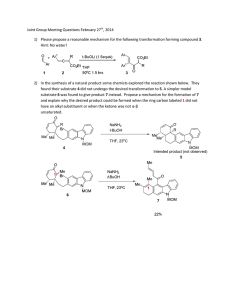n – WELL PROCESS
advertisement

CMOS FABRICATION n – WELL PROCESS Step 1: Si Substrate Start with p- type substrate p substrate Step 2: Oxidation Exposing to high-purity oxygen and hydrogen at approx. 1000oC in oxidation furnace SiO2 p substrate Step 3: Photoresist Coating Photoresist is a light-sensitive organic polymer Softens when exposed to light Photoresist SiO2 p substrate Step 4: Masking Expose photoresist through n-well mask Uv rays n-well mask P h o to r e s is t S iO p s u b s tra te 2 Step 5: Removal of Photoresist Photoresist are removed by treating the wafer with acidic or basic solution. P h otore s is t S iO 2 p s ub s trate Step 6: Acid Etching SiO2 is selectively removed from areas of wafer that are not covered by photoresist by using hydrofluoric acid. Photoresist SiO2 p substrate Step 7: Removal of Photoresist Strip off the remaining photoresist SiO2 p substrate Step 8: Formation of n-well n-well is formed with diffusion or ion implantation SiO2 n well Step 9: Removal of SiO2 Strip off the remaining oxide using HF n well p substrate wafer with n-well Step 10: Polysilicon deposition Deposit very thin layer of gate oxide using Chemical Vapor Deposition (CVD) process Polysilicon Thin gate oxide n well p substrate Polysilicon Thin gate oxide n well p substrate Step 11: N- diffusion N-diffusion forms nMOS source, drain, and n-well contact n well p substrate Oxidation n well p substrate Masking Step 11: N- diffusion Dopants were diffused or ion implantated n+ n+ n+ n well p substrate Diffusion Strip off oxide n+ n+ n+ n well p substrate Step 12: P- diffusion Similar set of steps form p+ diffusion regions for pMOS source and drain and substrate contact p+ n+ n+ p+ p+ n well p substrate n+ Step 13: Contact cuts The devices are to be wired together Cover chip with thick field oxide Etch oxide where contact cuts are needed Thick field oxide p+ n+ n+ p+ p+ n well p substrate n+ Step 14: Metallization Sputter on aluminum over whole wafer Pattern to remove excess metal, leaving wires Metal Thick field oxide p+ n+ n+ p+ p+ n well p substrate n+ p-well CMOS process The fabrication of p-well cmos process is similar to n-well process except that p-wells acts as substrate for the n-devices within the parent nsubstrate Advantages of n-well process n-well CMOS are superior to p-well because of lower substrate bias effects on transistor threshold voltage lower parasitic capacitances associated with source and drain region Latch-up problems can be considerably reduced by using a low resistivity epitaxial p-type substrate However n-well process degrades the performance of poorly performing p-type transistor Twin -Tub Process LOGIC GATES CMOS INVERTER NAND Gate NOR Gate STICK DIAGRAM Stick Diagram Colour Code P diffusion Yellow/Brown N diffusion Green Polysilicon Red Contacts Black Metal1 Blue Metal2 Magenta/Purple Metal3 Cyan/L.Blue Component Colour Use metal 1 metal 2 polysilicon Power and signal wires n-diffusion Signal wires,source and drain of transistors p-diffusion Signal wires,source and drain of transistors contact via Signal connection Power wires Signal wires and transistor gates Connection between metals NMOS transistor PMOS transistor INVERTER- STICK DIAGRAM Step 1 Two horizontal wires are used for connection with VSS and VDD. This is done in metal2, but metal1can be use instead. Step 2 Two vertical wires (pdiff and ndiff) are used to represent the p-transistor (yellow) and n-transistor (green). Step 3 The gates of the transistors are joined with a polysilicon wire, and connected to the input. Step 4 The drains of two transistor are then connected with metal1 and joined to the output. There cannot be direct connection from n-transistor to p-transistors. . Step 5 The sources of the transistors are next connected to VSS and VDD with metal1. Notice that vias are used, not contacts Alternative inverter metal1 is used instead of metal2 to connect VSS and VDD supply NAND Gate NOR Gate Layout Design Rules R1 R2 R3 R4 R5 R6 R7 R8 R9 Minimum active area width Minimum active area spacing Minimum poly width Minimum poly spacing Minimum gate extension of poly over active Minimum poly-active edge spacing (poly outside active area) Minimum poly-active edge spacing (poly inside active area ) Minimum metal width Minimum metal spacing 3L 3L 2L 2L 2L 1L 3L 3L 3L R10 R11 R12 R13 R14 R15 R16 R17 R18 R19 R20 Poly contact size Minimum poly contact spacing Minimum poly contact to poly edge spacing Minimum poly contact to metal edge spacing Minimum poly contact to active edge spacing Active contact size Minimum active contact spacing (on the same active region) Minimum active contact to active edge spacing Minimum active contact to metal edge spacing Minimum active contact to poly edge spacing Minimum active contact spacing (on different active regions) 2L 2L 1L 1L 3L 2L 2L 1L 1L 3L 6L OTHER CMOS LOGIC

